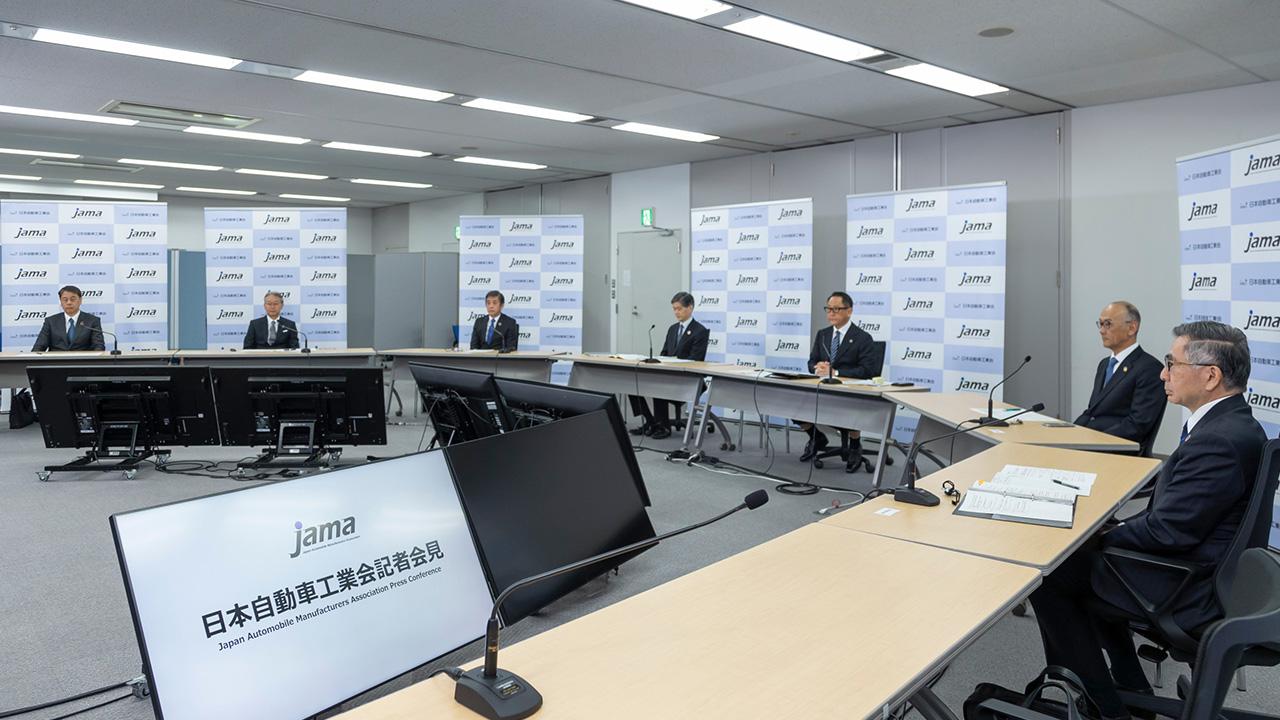
With its diverse range of technologies, Japan's auto industry seeks decarbonization through collaboration, not rivalry.
The expanding options of full lineup decarbonization
Diverse options for pursuing carbon neutrality will be on display at the G7 Summit.
“To offer a better understanding of our approach to diversity, we’d like to provide more information about each company,” prompted Chairman Toyoda. At this, the vice chairmen introduced specific efforts by their companies.
Vice Chairman Toshihiro Mibe (Honda)

Honda will have 10 electric motorcycle models available globally by 2025. We are also working towards an annual (BEV) target of 3.5 million, roughly 15% of Honda motorcycle sales, by 2030.
Similarly, for four-wheeled vehicles, we have set a goal of BEVs and FCEVs (fuel cell electric vehicles) accounting for 100% of global sales by 2040. To achieve these goals, alongside battery procurement and development, we are also forming robust partnerships with resource recyclers to ensure a stable supply of materials.
Vice Chairman Koji Sato (Toyota)

As we prepare a wide range of solutions, from BEVs to hydrogen, under our multi-pathway approach, we see the development of supply chains and infrastructure as crucial elements.
Through concrete action, we hope to show the world Japan’s unique approach to carbon neutrality. This mindset has driven our preparations for the G7.
Vice Chairman Masanori Katayama of Isuzu outlined the efforts of heavy-duty vehicle manufacturers.
Vice Chairman Katayama (Isuzu)

To begin with, we hope that seeing carbon-neutral commercial vehicles firsthand (at the Hiroshima venue) will make the future feel closer at hand.
We hope people will appreciate that, given the ways and environments in which commercial vehicles are used, diverse technologies are essential. To that end, we are showcasing commercial vehicles by multiple manufacturers, from light to heavy duty.
Next, Vice Chairman Yoshihiro Hidaka from Yamaha spoke on behalf of motorcycle manufacturers.
Vice Chairman Hidaka (Yamaha)

Yesterday, Honda, Suzuki, Kawasaki, and Yamaha announced that we will be setting up an organization for researching hydrogen fuels based on motorcycle internal combustion engines.
Our showpiece here at the G7 will be electric mobility solutions that use standardized replaceable batteries. Achieving their widespread adoption will rely on an ecosystem for reusing and recycling battery resources.
When it comes to replaceable batteries, using a universal model around the world would contribute to reuse and recycling. For this reason, we created Japanese standard replaceable batteries, which will also be on display.
Finally, Vice Chairman Toshihiro Suzuki of Suzuki commented on minivehicles.
Vice Chairman Suzuki (Suzuki)

For minivehicles, we will also be exhibiting electric options. In addition, one of our company’s own initiatives, a new energy vehicle, will be on display.
We are working on biogas production in India, with the dung from 10 cows capable of powering one car for a day. India is home to 300 million cows, which means 30 million vehicles could be run on cow dung.
Carbon neutrality can be achieved by making the most of such diversity and various ecosystems, rather than focusing solely on electrification. I see this event as a great opportunity to spread that message.
The auto industry, an attractive growth sector
Next, reporters asked about efforts to boost supply chain collaboration in the current social landscape, amid soaring resource and energy prices.

Vice Chairman Suzuki
I think dealing with the chip shortage taught us some very big lessons. (In responding to any changes in social conditions) we must communicate closely with our suppliers.
Although we frequently communicate with Tier 1 (primary suppliers), I think we need to connect more with Tier 2, Tier 3, and Tier 4. As we engage with other industries on the path toward electrification, JAMA will continue working to enhance communication.
Vice Chairman Katayama
One crucial aspect is figuring out how to expand areas of collaboration among companies.
By standardizing specifications across companies where possible, we can help to lighten the burden on suppliers and reduce development costs. For the customer, this will mean more stable procurement and lower prices, and in that sense, I believe JAMA’s efforts are becoming increasingly important.
Vice Chairman Nagatsuka
We are investing tremendous resources in capital, as well as R&D for carbon-neutral and CASE technologies. (Just among the seven passenger car companies) we have R&D expenditure of 3.4 trillion yen and capital investment of 3.5 trillion yen, totaling roughly 7 trillion, a record high.
Though we certainly have the figures to show that the auto industry is an attractive growth sector, we want to continue sharing its appeal through efforts such as this, and opportunities like the Japan Mobility Show.
The press conference featured much discussion of efforts by individual companies. Following the Q&A session, Chairman Toyoda wrapped up the proceedings.
Chairman Toyoda

The challenges of carbon neutrality and global warming should be addressed by all industries, not just the automotive industry.
From passenger cars to minivehicles, heavy-duty, and motorcycles—as well as powertrains that include BEVs, hydrogen, and HEVs—I believe the strength of Japan’s auto industry lies in the diversity of technologies.
Since we first began using the term “carbon neutrality” two years ago, Japanese automotive companies have earnestly and realistically pursued its true meaning, arriving at a correct understanding of our situation.
The enemy is carbon. I’m sure that everyone at the G7 Summit shares the same perspective. This is not about rivalry, but about working together to improve the global environment.
While a multi-pathway approach is our overarching message, with this many manufacturers coming together, it is also the reality and I believe the strength of Japan’s automotive companies.
Coming from the only nation to have endured an atomic bombing, Japan’s auto industry is driven to help ensure peaceful lives for all people. This mindset is accelerating efforts to achieve carbon neutrality.
The JAMA press conference was also followed by a presentation at the G7 Summit site in Hiroshima, where Toyota Chief Scientist Dr. Gill Pratt used okonomiyaki and ramen as examples in his explanation. Check out the video to see what he had to say.

